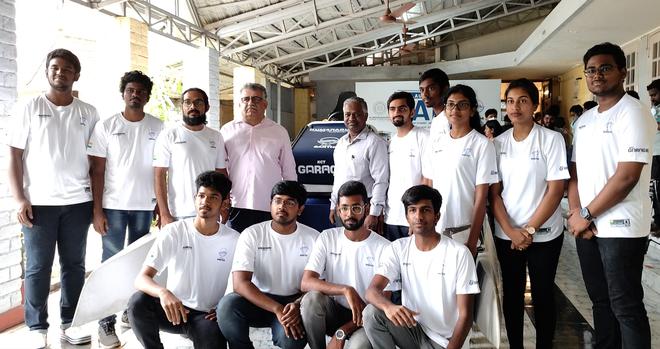At the Seamen’s Club near Chennai Port, a rather unassuming boat, compact in size and simple in make (or at least at the first look), is docked. Unexpected rains and delayed permits stall the possibility of a quick cruise.
Characterised by a small solar panel, white rudders, an electrical battery and a cockpit, the energy-efficient boat named YALI is now on its way to Monaco, as I write this, where it will compete in the ninth edition of the prestigious Monaco Energy Boat Challenge: a first for India.
Interestingly, YALI was born in landlocked Coimbatore, a city with little to no interaction with water sports or marine transport, in the garage of Kumaraguru College of Technology. It is the first student-made energy-efficient boat that will represent the country in July. The team, comprising 14 engineering students across departments such as Mechanical Engineering, Electrical Engineering, Electronics and IT calls itself Sea Shakti.
It all began in December 2021 following an open call for energy-efficient designs for marine trade and transport.
“As it is a student-driven competition, there were constraints. Safety had to be the main aspect. By staying within the rules and requirements, we had to come up with an optimum design solution,” says Kiranlal, the faculty-in-charge of Sea Shakti.

Though students of the college have had previous experience with building Formula Student cars and Go-Karts, this is the first time they are dipping their toes in marine architecture. And that too, keeping energy-efficiency and environmental implications in mind.
“The most challenging aspect of the Energy Class is to reduce the weight [of the boat] as much as possible. There was no question of steel. We initially thought of using carbon fibre, but it was too expensive,” adds Kiranlal. Aluminium, then, came to the rescue.
The primary source of energy will be the battery, while the secondary source is the solar panel.
“The solar panel will be charged from the sun and it will be stored in the battery, from which it will be sent to the propulsion system,” says Manav Samanth, analyst of the team.
“We are allowed to go upto 10,000 Watts of power, and the battery pack is restricted at 10 Kilowatts per hour. We decided to go for 6,000 W. In the category of Endurance, the boat will have to run continuously for two to three hours. With the power at 10,000 W, it is not feasible. To win every race, this is optimum,” says Kiran.
From almost 200 iterations, YALI is what they have arrived at. Over the course of designing, the team realised that electric pod motors meant for marine transport, are not in production in the country. So they imported a torpedo motor all the way from Germany. “The motor has to withstand seawater. Corrosive protection is a must,” adds Kiranlal.
The first dive
To create this boat, the students had to first learn marine architecture, since it is not part of the curriculum.
As none of them have any prior experience in water sports, Swaminathan who will pilot the boat along with Mohan says, “We attended a seven-day training in Kochi by the Kerala Water Sports Training Organisation, and the license was issued by Yachting Association of India. We did all the drills, and learned about basic sailing: from how to handle power boats to sustain in the water without rescues. Rescue drills were also part of this: we had to float in water for one-and-a-half hours.”
“The competition is divided into three categories: Energy, Solar and Open Sea. The Energy category has been there since 2018. They focus a lot on alternate propulsion systems and encourage the use of clean energy in the marine industry,” says Sanaa Mohammed on the larger impact of the competition, which advocates clean energy as a means to reduce pollution.
Finally, why YALI? “Initially we wanted to name her visai, kayal and so on. But we finally arrived at YALI inspired by the Indian mythological creature that is part horse, part lion and part elephant. We wanted to emphasise that she is fast as a horse, strong as an elephant and powerful as a lion,” concludes Sanaa.







